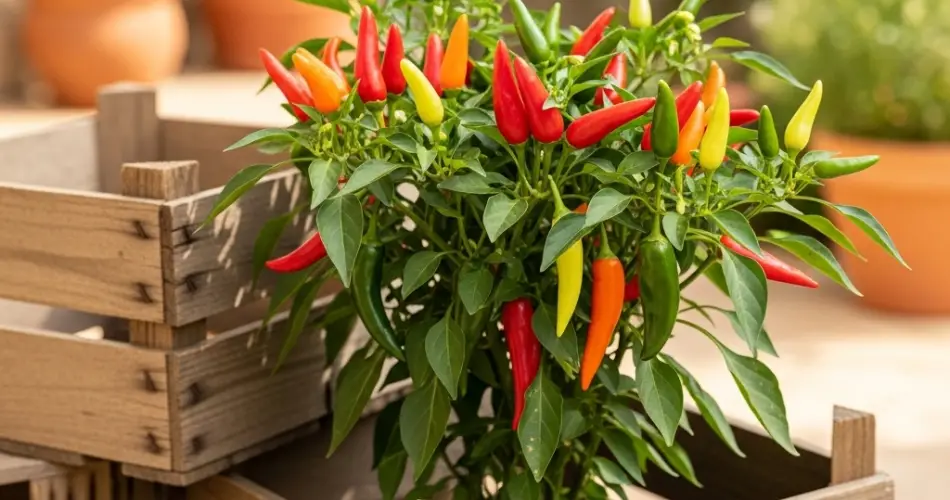Chilies are a popular choice for home gardeners, offering flavor, spice, and a rewarding harvest. While traditional garden beds work well, growing chilies in crates provides a practical solution for small yards, patios, or urban spaces. Crate gardening allows for better soil control, easier maintenance, and effective use of limited space, making it possible to produce vibrant, healthy chili plants with high yields.
By cultivating chilies in crates, gardeners can enjoy the convenience of raised beds combined with portability, pest control, and efficient nutrient management. Whether you prefer mild or hot varieties, crate-grown chilies can thrive with proper care and attention.
Why Grow Chilies in Crates?
Crate gardening offers several advantages for chili cultivation:
-
Space Efficiency – Ideal for compact areas, patios, and balconies.
-
Soil Management – Create a custom soil mix rich in nutrients and well-draining.
-
Mobility – Easily relocate crates to maximize sun exposure or protect plants from extreme weather.
-
Pest Reduction – Elevation decreases exposure to soil-borne pests and reduces disease risk.
-
Convenience – Crates keep plants organized, simplifying watering, feeding, and harvesting.
Raised crate gardens also help improve airflow around plants, which reduces fungal issues and promotes healthier growth.
Selecting the Right Crates
To grow chilies successfully, select crates that are:
-
Deep – At least 12–16 inches to accommodate roots.
-
Spacious – Wide enough to house multiple plants with proper spacing.
-
Sturdy and Untreated – Avoid treated wood to prevent chemical leaching.
-
Well-Draining – Drill holes or use slatted crates to allow excess water to escape.
Lining the inside with landscape fabric or burlap can help retain soil while allowing water to drain efficiently.
Choosing Chili Varieties
Choose chili varieties according to flavor preference, size, and growing conditions:
Mild Varieties:
-
Jalapeño
-
Cherry Pepper
-
Pimiento
Hot Varieties:
-
Thai Bird’s Eye
-
Cayenne
-
Habanero
Bush varieties are ideal for smaller crates, while taller, vining types may require stakes or cages for support.
Materials Needed
-
Wooden crate (12–16 inches deep)
-
High-quality potting mix with compost
-
Chili seedlings or seeds
-
Stakes, cages, or trellises for support
-
Mulch (straw, shredded leaves, or coco husk)
-
Fertilizer or compost tea
-
Sunny location with at least 6–8 hours of direct sunlight
Planting Chilies in Crates
-
Prepare the Soil
Fill the crate with nutrient-rich, well-draining soil. Incorporate compost or organic fertilizer to encourage strong growth and fruit development. -
Transplanting Seedlings
Space seedlings 12–18 inches apart depending on variety. Plant slightly deeper than in nursery pots to strengthen root systems. -
Direct Sowing
If sowing seeds, plant ¼ inch deep and thin seedlings after a few leaves develop to prevent overcrowding. -
Providing Support
Insert stakes, cages, or trellises at planting time for vining varieties to prevent stems from breaking under fruit weight.
Caring for Crate-Grown Chilies
-
Watering – Keep soil consistently moist but not waterlogged, particularly during flowering and fruiting. Avoid wetting leaves to reduce disease risk.
-
Feeding – Fertilize every 2–3 weeks with balanced fertilizer or compost tea to promote healthy foliage and fruit production.
-
Mulching – Apply 2–3 inches of mulch around plants to conserve moisture, suppress weeds, and regulate soil temperature.
-
Pruning – Remove any damaged or overcrowded leaves to improve airflow and encourage fruiting.
Managing Pests and Diseases
Even in crates, chili plants can face challenges:
-
Aphids – Spray with insecticidal soap or water to remove infestations.
-
Whiteflies – Monitor regularly and use organic deterrents as needed.
-
Fungal Diseases – Ensure good spacing, avoid overhead watering, and rotate soil each season to reduce the risk of disease.
Harvesting Chilies
Harvest chilies when they reach their full color and size, according to the variety. Regular picking encourages continued production throughout the season. Use scissors or gentle twisting to remove fruit without damaging stems. Green chilies can be harvested early, while leaving them to ripen enhances flavor and heat.
Extending the Growing Season
In cooler climates or during early frosts, crates can be moved to a warmer, sheltered area or protected with row covers. With sufficient sunlight and warmth, crate-grown chilies can continue producing into late autumn.
Final Thoughts
Growing chilies in crates is a practical and productive method for gardeners with limited space. Proper crate selection, nutrient-rich soil, and consistent care will result in healthy, high-yielding chili plants. Crate gardening not only maximizes space but also provides an organized, attractive way to cultivate flavorful chilies right in your backyard, patio, or balcony.



